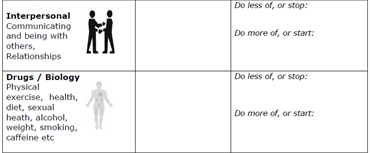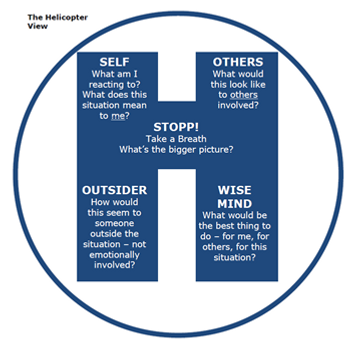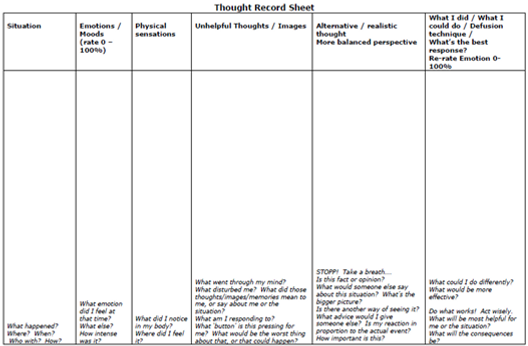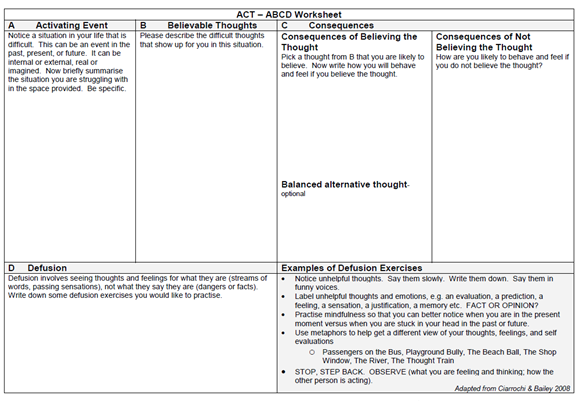7 self-help steps: cbt summary
“We don’t see things as they are, we see things as we are.” – Anais Nin

This blog consists of self-help Cognitive Behavioural Therapy (CBT) methods to help you overcome negative/unhelpful thoughts, and behaviours.
You can check the full self-help PDF here.
Please note: Self-help may not be suitable for everyone. You might need to get a therapist depending on your situation.
What Is Cognitive Behavioural Therapy (CBT)?
CBT is a form of therapy that consists of changing thought patterns and behaviours to increase wellbeing.
It’s beneficial for breaking negative thought cycles and it’s particularly effective for those struggling with a mental illness such as depression and anxiety.
Your past may be discussed to clarify where these thoughts and beliefs came from, but CBT mostly focuses on current issues and the future.
What I love about CBT is that it’s proven to be effective even if you do it to yourself with the correct strategies (we will go through them in this blog)!
Generally speaking, acting on the steps in this blog can make a significant improvement in your life and wellbeing, so make sure you try it.
However, if you find that this is not suitable for you, and you want to seek a therapist then please do so.
Step 1: Identifying Thoughts, Feelings, and Behaviours.
Our brain is constantly trying to make sense of everything, so we attach a meaning to anything that happens, see or hear.
Thoughts can be specific to us due to past or present experience, knowledge, values, culture or no good reason.
Some are very random or intrusive that can become quite distressing because we put meaning to it.
Thoughts that repeat over and over become a belief – then a chain comes from it making us feel worse and they can go on for a long time unless changed/broken.
It’s important to know that feelings that you experience come after thoughts.
So first we have an EVENT - then come the THOUGHTS/MEANING applied to the event – EMOTION.
For example, you go to a party, and someone doesn’t offer you a drink, but they do offer one to everyone else.
You may think, “oh they don’t like me, no one notices me or just forget me.”
This narrative can become a repetitive negative cycle that becomes your explanation for everything that happens.
This then can lead to distressing emotions such as feelings of worthlessness or being upset, and then maintain them.
A helpful way to interpret that event would be, “oh maybe they didn’t see me or didn’t think that I drink.”
Behaviour comes after the emotions.
If you are in distress, you’re more likely to withdraw from social events, places, and people.
To Help Break A Negative Cycle This Is What You Can Do:
Firstly, you need to identify current unhelpful thought patterns, and behaviours that lead to distressing emotions.
What recent event made you feel distressed/anxious/depressed/angry?
Write about the event in detail: what happened, when did it happen, what else was going on, was it a situation that you often find yourself in, who were you with?
Thoughts/images: what disturbed you? If you had that thought, what did that mean to you, or what did they say about you or the situation?
If your thought was a question, try to answer it.
Emotions: what did you feel?
Sensations in body: what did you feel in your body after feeling that emotion?
For instance, if you felt anxious then the fight or flight response may have triggered in your body causing change in breathing, sweatiness etc.
If you felt depressed then you may have experienced tiredness, appetite, or sleep changes.
Action: what did you do, or didn’t you do, how did you cope?

Asking these questions every time a situation comes up is good practice.
Note down every day for a week about a situation.
This will help you identify your thoughts, emotions, and behaviour.
Step 2: Understanding The Links Between Thoughts, Feelings, And Behaviours.
What links do you notice between what you think and what you do?
How does this affect the way you feel?
How you behave or act is followed by what you think.
You can change what you do to change how you feel.
Look at these example cogs:

Identify the biggest factor that is the most problematic and write it down.
Now what are the smaller factors that help maintain this problem?
These factors can be unhelpful things you do or think.
Target the smaller factors and write down what you can change and how, so you have an outline of changes that will work.
Step 3: Making Changes – Behaviours
Normally our reaction to things is automatic, so being more aware of how you react and if it’s helpful or not can help you make appropriate changes leading to changing how you think and feel.
Here are reflection questions about how you acted after a situation:
-
What helped you cope and get through it?
-
What didn’t I do or what did I avoid doing?
-
What automatic reactions did I have?
-
What would other people have seen me doing?
-
What were the consequences of what I did?
-
What happened later because of it?
-
Did it affect the way I felt later?
Now ask yourself, what could I have done differently?
What would someone else have done in that situation? (It might help to think about particular people that you know, and what they might have done differently).
Have there been times in the past when I would have done something else?
If I had paused, and taken a breath, what would I have done?
Write down several options that you might have done differently if it had occurred to you, then ask yourself:
-
If I had tried that, how would the situation have been different?
-
How would it have affected what I felt?
-
How would it have affected what I thought?
-
Would it have been more helpful or effective for me, another person or for the situation?
-
What would the consequences have been of doing something differently?
Dealing with a distressing situation:
Practice and learn to stop and take a breath before considering what action to take.
When deciding what to do:
-
Will it be effective and appropriate?
-
Is it in proportion to the event?
-
Is it in keeping with my values and principles?
-
What will be the consequences of my action?
-
What is best for me and most helpful for this situation?
Increasing activities and exercise alone can help improve our wellbeing significantly.
In your busy schedule, make sure to plan an activity everyday – even if it’s for just 30 minutes – that gives you a sense of achievement, closeness to others, and enjoyment (ACE).
Adding breathing or relaxation techniques will help combat the flight and fight response.








Step 4: Making Changes – Thoughts
Thoughts aren’t necessarily true or helpful.
There is no way that we could stop or control our thoughts.
They will come and go.
If we see them just as thoughts and let them pass, they can’t bother us.
After all, we can control our reaction to the thoughts. If we don’t give them meaning, they won’t stay!
Think of your inner criticising and judgemental thoughts as a bully that is trying to get to you.
There are 3 different ways that you could react to these thoughts.
-
Be a victim – believe the thought and get upset by it.
-
Challenge the thought – look for hard evidence to see if the thought is accurate or not.
-
Don’t react at all- acknowledge the thought, “oh it’s the same thing again” dismiss it and put your attention on something else.
Automatic thoughts just happen, and you may not even notice them.
They can be words, images, memories, physical sensations, imagined sound, or based on ‘intuition’ – a sense of just knowing.
They are often believable because we don’t challenge them.
We never stop to check their validity!
Unhelpful thinking habits consist of those that are mentioned in the image below.
You may favour some over others, and some might sound very familiar.
They usually come up before or during times of distress.
The benefit of knowing this is that once you identify the different types, you can notice them when they come and start challenging them.




Another great technique to question the validity of your thoughts is to know the difference between fact or opinion.
Facts have evidence to support it, are undisputed and are driven by rational thought.
Opinions are based on a belief/view, and it varies on an individual basis (knowledge, experience, culture, belief systems etc).
Opinions are also driven & reinforced by emotion.
During stressful times, emotions and opinions fuel each other leading to impulsive acts, and unhelpful longer-term consequences which maintain the overall problem.
Ask yourself if what you’re thinking is a fact or opinion.
If it’s a fact, then only think about moving forward. What can you do or can’t do?
If it’s an opinion, then go back to the facts. What do you already know about this situation?
Many thoughts are opinions.
Knowing this can decrease the likelihood of being distressed by them and make wiser and calm decisions about what to do.
Learning To See Things Differently – ‘The Helicopter View’
Because of our distress and the involvement in a situation makes it really difficult to see the bigger picture.
It’ll be helpful to take a step back and see the whole thing rationally.
Maybe imagine this “thing” happening to someone else.
How would you view it?
Every one of us has a different perspective on every situation.
We interpret conversations and events based on our beliefs and the meanings we apply to them.
“It is as though we are looking at the world through distorted or coloured lenses – and everyone has their own personal prescription or colour of their glasses.”
Everything that our mind tries to make sense of, or judge is influenced by our belief system.
Your core belief system consists of what you think about yourself, others, and the world.
And this system is influenced by factors such as past experiences, childhood upbringing, culture, faith, values, current circumstances, and character traits including genetic influences.
The mind can turn a good thing bad depending on your past experiences and beliefs.
The mental crusher makes sure of it.
The mental crusher sits outside our belief system and only allows information or evidence that fits with our belief system to enter our mind.
Any contradicting information is either rejected, dismissed, or made to fit your beliefs.
For example, someone looks at you. Your mental crusher distorts this information to, “they looked at me funny” to confirm that others dislike or mean to hurt you.
Use the ‘wise mind’ concept. The wise mind is a combination of emotions and rational thoughts.
It’s also the part that ‘just knows’ the truth.
Situations and people can be different to how we interpret them.
Seeing things from a different perspective can increase understanding and empathy improving relationships and the way we communicate.
As we keep challenging ourselves, we will be able to change our core limiting beliefs that make us see the world in an unhelpful distorted way.

Step 5: Challenging Our Thoughts
Write down thoughts from a recent distressing situation.
What did those thoughts say about you or mean to you? Which thought or image was the one that made you most upset?
Ask these questions about the most distressing thought:
-
Is this thought a fact, or my opinion?
-
What am I reacting to?
-
What meaning am I giving this situation?
-
Is there another way of looking at it?
-
What would someone else make of it?
It's often helpful to think about a particular person who you respect, and imagine what they would think about that thought, what meaning they would give it, and how they would react to it.
-
What advice would I give someone else?
-
Is this one of those Unhelpful Thinking Habits?
-
Is my reaction in proportion to the actual event?
-
How important is this really?
-
How important will it be in a year's time?
-
How am I reacting?
When I think of my thoughts as a bully, am I believing and getting upset by them, or can I challenge the bully?
-
What if I tried to see this situation as an outside observer? How would that look? Would things be likely to have a different meaning?
-
What evidence is there that this thought is true?
-
What evidence is there that this thought isn't true (partly or totally)?
-
What would be a more balanced way of looking at it?
What is the bigger picture?





Use these sheets once daily to get good practice and make a difference.
Step 6: Distancing Or Defusing From Thoughts
Defusing a thought means to acknowledge the thought as a thought, not reacting to it automatically, and putting your attention somewhere else.
Thoughts can be described as passing images or sensations.
We don’t have to accept them as facts and engage with them.
Mindfulness is a practice where you would focus on your breath and when you notice that the mind is wandering, you bring your attention back to the breath.
You can participate in mindful activities such as washing dishes, and walking.
Just bring your attention back to the activity when the mind wanders.
Use the 5 senses. Maybe you can experience your routine differently.
Maybe pretend to be a visitor.
Look around at the environment like you haven’t seen it before.
Inspect your body like you’re in it for the first time - what does it feel like?
How does your breath feel in different parts of the body?
Notice thoughts and emotions like it’s all coming for the first time ever.
Use the NOW acronym to stay present:
Notice: where my attention is.
Observe: what am I doing? Say to yourself what you are doing.
Wise mind: what now? How shall I continue? Doing or being?
Choose an activity you can do mindfully throughout the day.
Whatever you’re doing, be in that moment, right now.
Refocus yourself on the activity.
Practicing mindfulness will eventually help you bring awareness to your thoughts and then let them go.
Living and being aware moment to moment can stop us from triggering habitual thinking that is not helpful.
By doing so we give us more freedom and choice.
STOP, take a breath, and ask yourself these questions which will help you defuse or distance yourself from your thoughts:
-
What's happening right now? What thoughts, feelings and sensations do I notice?
-
What am I reacting to? What meaning am I giving this event? How is this affecting me?
-
Is this fact or opinion?
-
What is the result of my believing this thought?
-
What would be the effect of not believing this thought?
-
Is this a thought, a feeling, or a sensation?
-
Am I predicting what might happen in the future?
-
Am I evaluating a situation? How might I describe it instead?
-
Is this a memory from the past?
-
Is this one of those Unhelpful Thinking Habits?
Perhaps write the thought down, get it out of your head and onto paper.
Maybe repeat the thought in a strange or comical voice or say it very quickly or very slowly - words can lose or change their meanings.
Can I use a metaphor for this situation?
Remember at the end of the day: It is what it is. It will pass.



Step 7: Imagery
Visualisation has been a major and well-known factor for overcoming different challenges as well as achieving future success.
That being said, you can use visualisation to overcome mental ruts.
Here are 7 ways to use visualisation:
You can have a safe place imagery – go to a place where you want to (doesn’t have to be where you have been in real life).
Use all 5 senses to really get into it.
If you struggle with visualising (like I do) Google a picture of what you consider a safe place and memorise it so you can visualise it later.
Also name this place so you can use it anytime.
Wise inner advisor - we all have the answers deep within us.
Picture your safe place and imagine someone that represents wisdom to you maybe an old man, spiritual figure, parent.
Make the vision stronger by imagining with all 5 senses and ask them for advice, be receptive.
Don’t expect an immediate answer it may come to you in a few days.
Boost self-esteem - imagine yourself as what you would like to be or someone else (fictional) whose qualities you would like.
How do they act? Look like? Behave etc.
How do you feel now – associate your feeling with the image and give it a name, so you can bring it back whenever you need it.

Image manipulation – Use this if you’re getting distressing intrusive images.
Imagine that image on a TV screen and change it with a TV remote control by making it smaller, or black and white, and changing the sound.
Imagine a plate or sheet with clear plastic and put it between your face and the image.
Push it away from your face until it gets smaller and further away.
Turn around a bad feeling – if you have weird/bad feeling imagine it as a shape big and any dark colour and then make it smaller and give it a bright colour.
Positive imagery for depression – imagine activity/activities you used to enjoy 2-3 times a day.
Use all 5 senses, really start enjoying it.
Lastly, remember that CBT requires practice. Repeat these skills with hard work and commitment.
Practice during times that you don’t even need it.
The more you do this, the more clarity you will achieve.
This is crucial for living life freely and happily.
What has worked out for you? Can you give some tips in the comments below about overcoming negative thoughts?
Read, share, comment, and let me know what you think!



